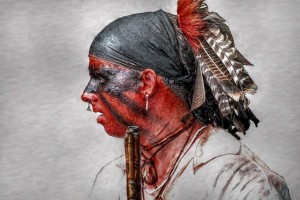
Delaware Indian Warrior - by Artist Randy Steele - Source: http:// fineart america .com /featured /french -and -indian -war -delaware -indian -warrior -randy -steele. html
The Delaware Indians (Lenni Lenape) were named by the Europeans because of their close proximity to the Delaware river which was named after Lord De La Warr, Governor of Jamestown. The Delaware language belonged to the Algonquian family of Indian dialects. Early tribes were organized as language groups rather than individual tribes. In Lenni Lanape society families followed the woman’s line of descent.
The Delaware’s were among the first Native Americans to come in contact with Europeans beginning in the early 1600s with the fur trade. In their early history they were often the peacemakers in disputes between other rival tribes and were seen as a very peaceful people even in the Cumberland Valley area until after the French and Indian War began to change white settler’s perceptions of all Indians. Francis Parkman author of The Conspiracy of Pontiac notes that the Delaware Indians believed that land belonged to everyone and therefore could not be sold. When selling land treaties with white settlers the Indians granted land usage not ownership. It was conflict over land ownership that ultimately triggered a brutal battle for survival on the American frontier that would continue unabated into the beginning of the 20th Century.
As more and more British Colonists migrated to America their movement forced the Delaware Indians to withdraw westward across the Appalachian Mountains into Ohio country. Here they came into contact with French traders who provided them with European goods including guns and alcohol in exchange for furs. The French and Indian War disrupted the alliance particularly after the Treaty of Paris in 1763 which caused the French to abandon their territories in North America.
Because of their distrust of British and American colonist many of the Delaware’s joined Pontiac’s War and were part of the siege at Fort Pitt in 1763 to 1764. Pontiac’s War came to the Cumberland Valley when three Delaware Indians murdered and scalped school master Enoch Brown and ten school children on July 26, 1764 near present day Greencastle, Pennsylvania. This event was widely considered to be the main reason Justice William Smith was so concerned about the safety of the Conococheague settlement as a result of trade with the Indians.
During the American Revolution the frontier war for survival continued as if no war for independence was taking place. There were many instances of brutality on both sides. One such incident was the 1782 Gnadenhutten Massacre, where Pennsylvania militia men killed over one hundred peaceful Christian Delaware Indians living in a Moravian mission. They were killed mainly because they were Indians although a flimsy defense of the Pennsylvania militia stated it was believe they had participated in recent frontier raids.
Following America’s becoming an independent nation the Delaware Indians continued to resist a renewed flood of settlers into Ohio. In 1794 General Anthony Wayne defeated the Delaware tribe at the Battle of Fallen Timbers in Ohio. After this battle they surrendered most of their Ohio lands and in 1795 signed the first treaty with the new American nation when they signed the treaty of Greenville. By 1829 the United States government forced the Delaware tribe to move west across the Mississippi river into modern day Oklahoma where most of the tribe resides today.
Sources:
The Conspiracy of Pontiac. Parkman, Francis. Little Brown and Co. Boston, Mass. 1898
Our Savage Neighbors: How the Indian War Transformed Early America. Silver, Peter. W.W. Norton & Co. New York, NY. 2008
American Leviathan: Empire, Nation, and Revolutionary Frontier. Griffin, Patrick. Hill and Wang A division of Farrar, Straus and Giroux. New York, NY. 2007
The Delaware Tribe – Wikipeida A free Encyclopedia http://en.wikipedia.org/wiki/Delaware_Indians